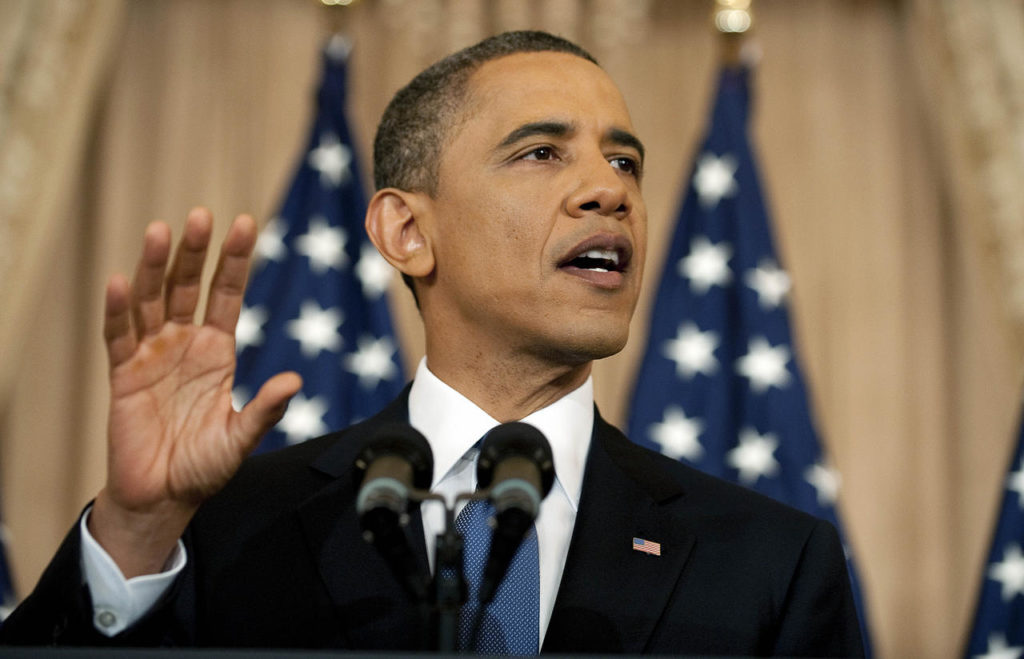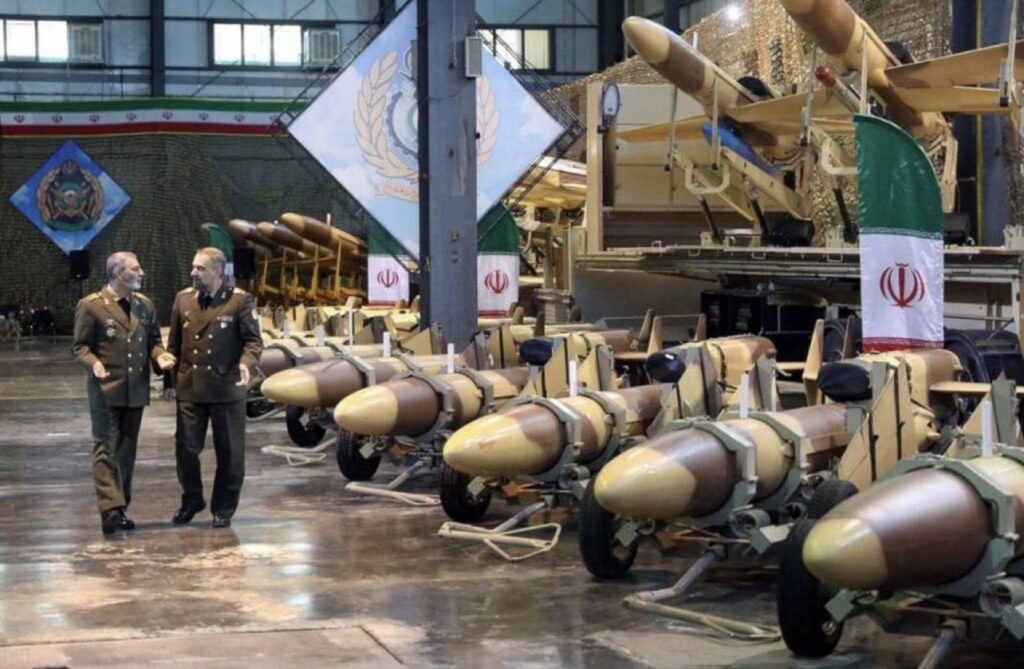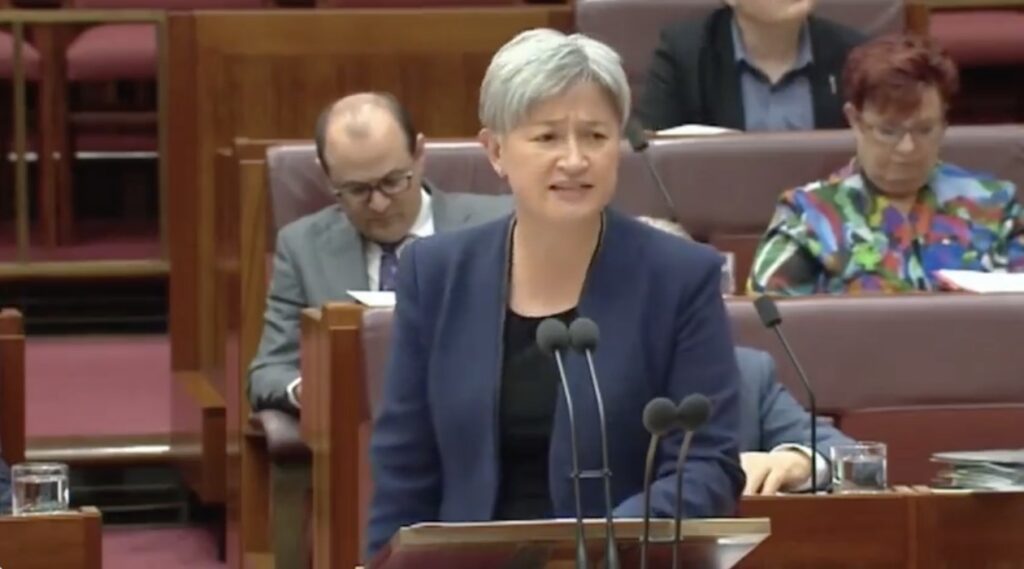UPDATES
Obama’s Middle East Speech
May 20, 2011

Update from AIJAC
May 20, 2011
Number 05/11 #06
As readers are probably aware, US President Barack Obama gave an important speech last night on US Middle East Policy in response to the Arab Spring – which can be read in full here, and can be viewed here. This Update deals with its policy statements across various issue areas as well as their ramifications.
First up is Robert Satloff, director of the Washington Institute for Near East Policy, who discusses the implications of what Obama said particularly with respect to Israeli-Palestinian issues. He is critical of three elements of the speech which go beyond the Clinton parameters for a deal set back in 2000 – his enunciation of the principle that a deal should be “based on the 1967 lines with mutually agreed swaps,” a rejection of an Israeli military presence in the Jordan valley in a deal, and “a borders-and-security-first approach, leaving the subjects of refugees and Jerusalem for future negotiations”. Satloff points out that these are all US movements toward the Palestinian position – just as the Palestinian Authority had signed a highly destructive agreement with Hamas, and is likely to lead to a rift with Israeli PM Netanyahu, currently due in Washington. For Satloff’s complete analysis of the problems with these key points, CLICK HERE. More on problematic elements of the speech for Israeli-Palestinian peacemaking comes from American journalists Benny Avni and Jonathan Tobin. Meanwhile, an interesting debate about whether the “1967 line” declaration is really new and unprecedented pits Jonathan Tobin and Omri Ceren (arguing “yes”) against Jeffrey Goldberg (arguing “no”). However, the most interesting take on this (roughly “It’s not really new, but it was a gaffe in the circumstances”) comes from Jackson Diehl of the Washington Post.
Next up is a parsing of the various key phrases in the speech from American columnist Charles Krauthammer. Krauthammer notes strong parallels between elements of Obama’s rhetoric about regional democratisation and that of the Bush Administration. Krauthammer also makes some similar points to Satloff about the 1967 lines issue, and also notes some ambiguity about Palestinian “contiguity” and Israeli settlements. For his complete parsing of the speech, CLICK HERE. Agreeing with Krauthammer that the Obama speech sounded rather “neocon” in places is security expert Max Boot. Another parsing of the speech’s key phrases comes from noted author and intellectual Thomas Burnett.
Finally, we bring a broader look at the speech’s policy implications vis-a-vis the “Arab Spring” movements, from noted Israeli writer Shmuel Rosner. Rosner notes that the speech is essentially about a policy of not “nation-building” but “nation-facilitating”, and points out this is a distinctly unromantic, non-“sexy” pursuit, but nonetheless, a worthy one. He also has some interesting analysis of what he believes is a “political rubicon” crossed by Obama with regard to the Syrian internal violence. For the rest of Rosner’s argument, CLICK HERE. A more detailed look at the Syria elements of the speech comes from Andrew Tabler of the Washington Institute.
Readers may also be interested in:
- Israeli PM Binyamin Netanyahu’s reaction to the speech as he was on his way to Washington.
- Reactions to the speech from US political opponents of Obama, from Hamas, and from across the Arab world.
- Some more analysis of the speech here, here, here and here.
- Following up on Abbas’ New York Times claims regarding his family’s 1948 departure from Safed, noted in the last Update, historian Efraim Karsh has a detailed discussion of what actually occurred in that town in 1948.
- Jackson Diehl has an excellent pre-speech piece on how Mahmoud Abbas is setting the stage for another major conflict with Israel.
President Obama, the ‘Winds of Change,’ and Middle East Peace
By Robert Satloff
Policy Alert, May 19, 2011
President Obama did a great service in sketching out a new paradigm for U.S. engagement with the Middle East in his State Department “winds of change” speech this afternoon, in which he raised the goal of reform and democracy to a top-tier U.S. interest. Nevertheless, after critiquing Arab regimes that have used the Arab-Israeli conflict to distract their peoples from the important business of reform, he undermined the potency and effect of his own message by unveiling a new — and controversial — set of principles guiding U.S. efforts to promote Israeli-Palestinian peace.
Specifically, the peace process principles he articulated constitute a major departure from long-standing U.S. policy. Not only did President Obama’s statement make no mention of the democracy-based benchmarks injected into this process by President Bush in his June 2002 Rose Garden speech (which might have been appropriate, given the overall theme of his speech), he even included significant departures from the “Clinton Parameters” presented to the parties by the then president in December 2000:
- President Obama is the first sitting president to say that the final borders should be “based on the 1967 lines with mutually agreed swaps.” (The Clinton Parameters — which, it is important to note, President Clinton officially withdrew before he left office — did not mention the 1967 borders, but did mention “swaps and other territorial arrangements.”) The Obama formulation concretizes a move away from four decades of U.S. policy based on UN Security Council Resolution 242 of November 1967, which has always interpreted calls for an Israeli withdrawal to a “secure and recognized” border as not synonymous with the pre-1967 boundaries The idea of land swaps, which may very well be a solution that the parties themselves choose to pursue, sounds very different when endorsed by the president of the United States. In effect, it means that the U.S. view is that resolution of the territorial aspect of the conflict can only be achieved if Israel cedes territory it held even before the 1967 war.
- Regarding IDF deployment, President Obama said that the Palestinian state should have borders with Egypt, Jordan, and Israel, and referred to the “full and phased” withdrawal of the Israel Defense Forces. This statement implies categorical American opposition to any open-ended Israeli presence inside the future Palestinian state. This differs from the Clinton Parameters, which envisioned three Israeli “facilities” inside the West Bank, with no time limit on their presence.
- Although the president noted that he was endorsing a borders-and-security-first approach, leaving the subjects of refugees and Jerusalem for future negotiations, this is an odd reading of the relevance of those two issues. For Palestinians, the refugee issue may be powerfully emotive, going to the core of Palestinian identity; for Israelis, however, it is as much an issue of security as ideology. For the president not to repeat previous U.S. government statements — e.g., that Palestinians will never see their right of return implemented through a return to Israel — is to raise expectations and inject doubt into a settled topic. of
Perhaps more than anything else, the most surprising aspect of the president’s peace process statement was that it moved substantially toward the Palestinian position just days after the Palestinian Authority decided to seek unity and reconciliation with Hamas. Indeed, the president seemed nonplussed that Mahmoud Abbas, president of the Palestinian Authority, has opted for unity with Hamas, a group the United States views as a terrorist organization. This reconciliation with Hamas “raises profound and legitimate questions for Israel,” the president noted — but evidently not questions so profound and troubling to the United States that they would impede a shift in U.S. policy that advantages the Palestinians.
Also odd was the fact that the president offered no implementation mechanism to translate these ideas into real negotiations. He named no high-level successor to Sen. George Mitchell, the peace process envoy who just resigned, nor did he specifically call for the immediate renewal of negotiations.
Despite this absence of a new mechanism, the likely next step is for Palestinians to take up the president’s call, ask for renewal of negotiations on precisely the terms the president outlined — borders that are “based on the 1967 lines with mutual swaps,” with no reference to refugees or other issues on which the Palestinians would make major compromises — and wait for Israel to say no.
Now en route to Washington, Israeli prime minister Netanyahu has already issued a statement objecting to the president’s focus on the 1967 borders. The two leaders may find a way to blur their differences over the principles outlined today, given their partnership on strategic issues and mutual interest in political cooperation and amity. But the approach to Israeli-Palestinian peace enunciated today has within it the seeds of deepening tension and perhaps even rift between the two sides — the very distraction from the focus on democratic reform the president said he wanted to avoid.
Robert Satloff is The Washington Institute’s executive director and Howard P. Berkowitz chair in U.S. Middle East policy.
Back to Top
————————————————————————
The news in Obama’s speech
By Charles Krauthammer
Washington Post, May 20, 2011
Herewith President Obama’s Middle East speech , annotated:
“It will be the policy of the United States to promote reform across the region, and to support transitions to democracy.”
With this Barack Obama openly, unreservedly and without a trace of irony or self-reflection adopts the Bush Doctrine, which made the spread of democracy the key U.S. objective in the Middle East.
“Too many leaders in the region tried to direct their people’s grievances elsewhere. The West was blamed as the source of all ills.”
Note how even Obama’s rationale matches Bush’s. Bush argued that because the roots of 9/11 were to be found in the deflected anger of repressed Middle Eastern peoples, our response would require a democratic transformation of the region.
“We have a stake not just in the stability of nations, but in the self-determination of individuals.”
A fine critique of exactly the kind of “realism” the Obama administration prided itself for having practiced in its first two years.
How far did this concession to Bush go? Note Obama’s example of the democratization we’re aiming for. He actually said:
“In Iraq, we see the promise of a multiethnic, multisectarian democracy. There, the Iraqi people have rejected the perils of political violence for a democratic process . . . Iraq is poised to play a key role in the region.”
Hail the Bush-Obama doctrine.
“President Assad now has a choice: he can lead that transition [to democracy], or get out of the way.”
The only jarring note in an otherwise interesting, if convoluted, attempt to unite all current “Arab Spring” policies under one philosophical rubric. Convoluted because the Bahrain part was unconvincing and the omission of Saudi Arabia was unmistakable.
Syria’s Assad leading a transition to democracy? This is bizarre and appalling. Assad has made all-out war on his people — shooting, arresting, executing, even using artillery against cities. Yet Obama is still holding out the olive branch when, if anything, he should be declaring Assad as illegitimate as Gaddafi. Clearly, some habitsof engagement/appeasement die hard.
“A lasting peace will involve . . . Israel as a Jewish state and the homeland for the Jewish people, and the state of Palestine as the homeland for the Palestinian people.”
Meant to reassure Israelis that the administration rejects the so-called right of return of Palestinian refugees. They would return to Palestine, not Israel — Palestine being their homeland, and Israel (which would cease to be Jewish if flooded with refugees) being a Jewish state. But why use code for an issue on which depends Israel’s existence?
“The borders of Israel and Palestine should be based on the 1967 lines with mutually agreed swaps.”
A new formulation favorable to maximal Arab demands. True, that idea has been the working premise for negotiations since 2000. But no president had ever before publicly and explicitly endorsed the 1967 lines.
Even more alarming to Israel is Obama’s omission of previous American assurances to recognize “realities on the ground” in adjusting the 1967 border, meaning U.S. agreement that Israel would incorporate the thickly populated, close-in settlements in any land swap. By omitting this, Obama leaves the impression of indifference to the fate of these settlements. This would be a significant change in U.S. policy and a heavy blow to the Israeli national consensus.
“The Palestinian people must have the right to govern themselves . . . in a sovereign and contiguous state.”
Normal U.S. boilerplate except for one thing: Obama refers to Palestinian borders with Egypt, Jordan and Israel. But the only Palestinian territory bordering Egypt is Gaza. How do you get contiguity with Gaza? Does Obama’s map force Israel to give up a corridor of territory connecting the West Bank and Gaza? This is an old Palestinian demand that would cut Israel in two. Is this simply an oversight? Or a new slicing up of Israel?
Finally, in calling for both parties to “come back to the table,” the Palestinians have to explain “the recent announcement of an agreement between Fatah and Hamas. . . . How can one negotiate with a party that has shown itself unwilling to recognize your right to exist?”
Not a strong statement about Washington rejecting any talks involving Hamas. A mere placeholder.
On the other hand, Obama made no mention here of Israeli settlements. A mere oversight? Or has Obama finally realized that his making a settlement freeze a precondition for negotiations — something never demanded before he took office — was a disastrous unforced error? One can only hope.
Back to Top
————————————————————————
Goodbye Nation-Building, Hello Nation-Facilitating
The vision and the frustration behind Obama’s Middle East speech
By Shmuel Rosner
Slate.com
Posted Thursday, May 19, 2011, at 4:58 PM ET
Do you remember how wisely, how patiently, President George H.W. Bush presided over Eastern Europe’s transition from communism to freedom? Do you remember how calm he was when the Soviet Union suddenly collapsed? Now think again: Do you remember any of the speeches Bush made during that period? And if you happen to be one of the few policy wonks (or freaks) who do remember, do you recall any of Bush’s orations more than you remember Ronald Reagan’s “tear down this wall” speech?
Dramatic events are now transforming the Middle East. They are surprising, exciting, and frightening the people of the region and those watching them from afar. “[T]he events of the past six months show us that strategies of repression and strategies of diversion will not work anymore”‘ President Barack Obama said today in one of the overstatements included in his much-anticipated Middle East policy speech. People think that great changes like this provide the proper background for great speeches. But that isn’t quite true.
Most great speeches are recognized as such because of the boldness of a timely call to action that follows the speech. Alas, in the Middle East, the United States has not assumed the role of an active player and was never expected to intervene in most of the restive countries (Libya being the exception). “The question before us is what role America will play as this story unfolds,” Obama declared. The United States was taken by surprise when the uprisings started, and now it is cautiously navigating its way day by day, week by week, country by country, despotic ruler by despotic ruler. Mostly, Washington is trying not to make mistakes, not to interrupt, not to fall on the wrong side of the history that other people are driving.
There was no tear-down-this-wall moment for Obama as he tried to clarify U.S. policy in the region at this troubled time. Hence the smart and calculated economic measures aimed at assisting Middle East reformers who want to navigate the treacherous path to modernity and liberalism—that’s smart, but not exactly exciting or inspiring. Here’s one of Obama’s action items: “We’ve asked the World Bank and the International Monetary Fund to present a plan at next week’s G8 summit for what needs to be done to stabilize and modernize the economies of Tunisia and Egypt.” To his credit, Obama is trying to do what’s possible and what might be of value. But by doing so, he might have to face the annoying fate that befell Bush senior: presiding responsibly over the revolution that his predecessor will get credit for making happen.
It must be frustrating for a country of doers, such as America, to have to assume the role of the bystander. It must be frustrating for a young and ambitious president to have nothing more to offer than encouragement, analysis (“change of this magnitude does not come easily”), opinions (“Coptic Christians must have the right to worship freely in Cairo”), and funding (“we will relieve a democratic Egypt of up to $1 billion in debt”)—pending good behavior and congressional approval. If the first decade of the 21st century was marked by the great debate about America’s attempt at “nation-building” in the greater Middle East, it seems that the second decade will consign Americans to “nation-facilitating.”
Facilitating new nations sounds important enough—and it is important. Some of the measures Obama announced today might also prove to be meaningful and helpful. But if you have any doubts as to whether facilitating is as significant as building, try imagining Bob the Builder turning into Bob the Facilitator, and you’ll see why Obama’s speech seemed a little stiff, a little boring, marred with the language and detail of “development” (three times), “process” (twice), and lots of dull, procedural words (“a comprehensive Trade and Investment Partnership Initiative”). The builder is manly, active, risk-taking; the facilitator is more bureaucratic, more lawyerly, dare I say more of an Obama than a Bush?
The president’s message was understandably upbeat. He was trying to argue that this is a time of opportunity—and that might still prove to be true. But let’s not ignore reality. Right now, the Middle East is a total mess. The Egyptian revolution is stuck in midair; the Libyan mission has yet to be successful; Syria is soaked in blood; Palestinians are being killed as they try to force their way across the Israeli border; Lebanon is barely independent; Bahrain is trembling; Iran is still advancing its military nuclear program; and the list goes on.
It’s fine for the president to argue that the timely achievement of killing Osama Bin Laden will be a watershed event, leading to a freer, more prosperous, and more moderate Middle East. It is fine for him to hope, as long as such hope isn’t mistakenly or deliberately confused with reality.
Obama’s Middle East speech wasn’t at all revolutionary; it didn’t present any ideas we haven’t heard before; it didn’t come up with strategy that will one day be called “grand.” But that doesn’t mean the speech wasn’t good or worthy. “[W]e must proceed with a sense of humility,” Obama said, and with such proper humility he made a leap of both faith and some courage. In fact, this leap was felt more concretely earlier this week, when the Obama administration slapped Syrian President Bashir Assad with more meaningful sanctions than those of previous cycles, demanding that he “lead a political transition or leave.” This looks like the crossing of a political Rubicon.
Consider this: Obama will have two distinguished guests in the White House this week, King Abdullah of Jordan and Prime Minister Benjamin Netanyahu of Israel. Both countries have a border with Syria. Both leaders loathe Assad and condemn his behavior, but both also dread the possible consequences for Syria and its neighbors if and when Assad leaves the scene. Both leaders came to Washington to hear that Obama had already made up his mind: He is going to push the butcher of Damascus around as much as he possibly can, no matter how bad a short-term impact this might have on Syria’s neighbors. He is going to support the restive Syrians, even though he has no way of knowing what the outcome of regime change in Damascus might be.
Obama made a commitment by tightening the noose around Assad, and he sealed this commitment in today’s speech. He seems to have made his peace with the policy Washington will pursue: no more looking the other way, no more nuance, no more exceptions. “The status quo is unsustainable.” From now on, the United States will support the restive publics throughout the Middle East. From now on, fear of chaos and instability is being pushed aside. Quoting President George W. Bush’s second inaugural address would have been the masterstroke—it didn’t happen this time, but there may be another opportunity down the road. Didn’t Bush say it all: “[I]t is the policy of the United States to seek and support the growth of democratic movements and institutions in every nation and culture, with the ultimate goal of ending tyranny in our world.”
Tags: Israel











